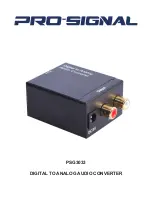
22
Why
won’t
some
media
files
play
properly?
The
video
data
bit
‐
rate
used
may
have
exceeded
the
recommended
bit
rate.
The
video
data
bit
‐
rate
is
the
amount
of
video
or
audio
data
used
per
second
to
store
or
play
the
contents,
usually
expressed
in
Mbps
(mega
‐
bits
per
second).
Video
encoded
with
excessive
bit
‐
rates
will
not
playback
smoothly
in
the
media
player,
likely
due
to
storage
I/O
bottleneck.
Visit
http://support.iadea.com
for
compatible
media
format
presets.
The
media
playback
looks
different
on
a
PC
compared
to
the
media
player’s
screen.
(Wrong
aspect
ratio)
There
are
2
major
aspect
ratios
(width
‐
to
‐
height
ratios)
for
video
content,
but
many
kinds
of
displays.
If
you
play
4:3
video
on
a
16:9
display
(or
vice
versa),
a
circle
becomes
oval,
and
the
picture
takes
on
a
squeezed
or
stretched
look.
To
avoid
this
distorted
look,
adding
black
bars
are
a
common
technique.
The
Network
Media
Player
can
be
configured
to
automatically
add
black
bars
for
certain
types
of
displays.
You
can
set
the
output
resolution
in
DNP50
/
DNP50
AVW’s
configuration
menu
to
match
the
native
resolution
of
your
display.
Some
JPEG
images
cannot
be
played
in
the
media
player.
Progressive
JPEG
files
are
not
supported.
Please
convert
to
baseline
JPEG
for
maximum
compatibility.
JPEG
images
can
be
either
of
2
types:
baseline
or
progressive
compression.
Baseline
JPEG
offers
greatest
compatibility,
while
progressive
JPEGs
are
suitable
for
web
site
images.
Progressive
images
are
downloaded
and
displayed
“progressively,”
being
rendered
more
clearly
as
more
data
is
received
over
the
internet.
Progressive
images
are
primarily
supported
on
PCs.
For
media
appliances,
make
sure
to
save
images
as
baseline
JPEG
in
your
photo
editor,
or
resave
them
as
baseline
JPEGs
using
free
tools
such
as
IrfanView
(
http://www.irfanview.com/
).
Does
the
media
player
support
video
streaming?
No.
Drake
DNP50
/
DNP50
AVW
/
DNP100
Network
Media
Players
play
media
files
from
local
storage
and
do
not
support
real
‐
time
video
streaming
over
the
network.
This
delivers
an
optimal
viewing
experience
free
of
playback
quality
issues
such
as
stuttering,
blocking,
or
blue
‐
screens.
The
media
player
is
not
playing.
What
should
I
do?
Play
list
errors
and
scheduling
issues
are
two
major
causes
of
playback
problems.
To
determine
if
the
problem
is
caused
by
a
bad
playlist,
just
delete
the
playlist
and
restart
the
player.
The
player
should
loop
through
all
media
files,
indicating
a
fault
with
the
play
list.
If
the
playback
is
scheduled
to
play
at
specific
time,
check
to
see
if
the
device
is
set
to
the
right
time
zone
on
the
world
clock.
If
nothing
seems
wrong,
the
time
zone
setting
is
often
the
reason
the
program
is
not
played.




































